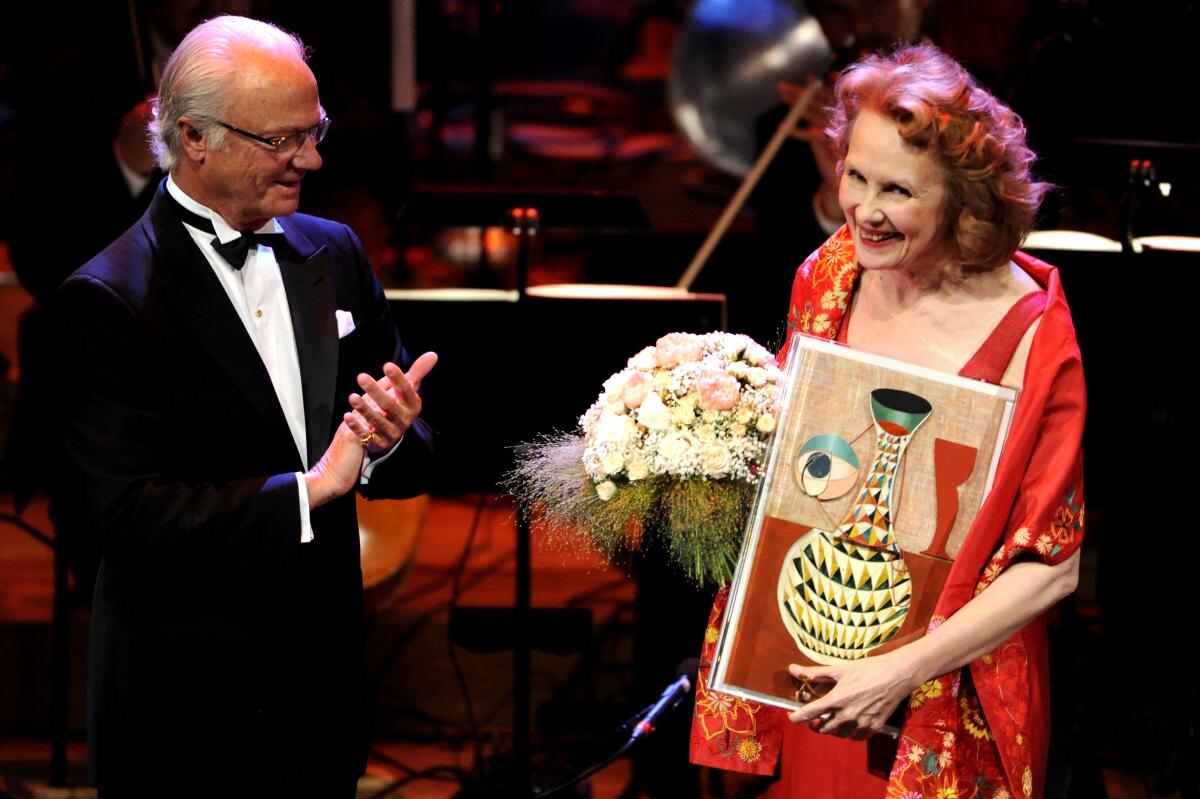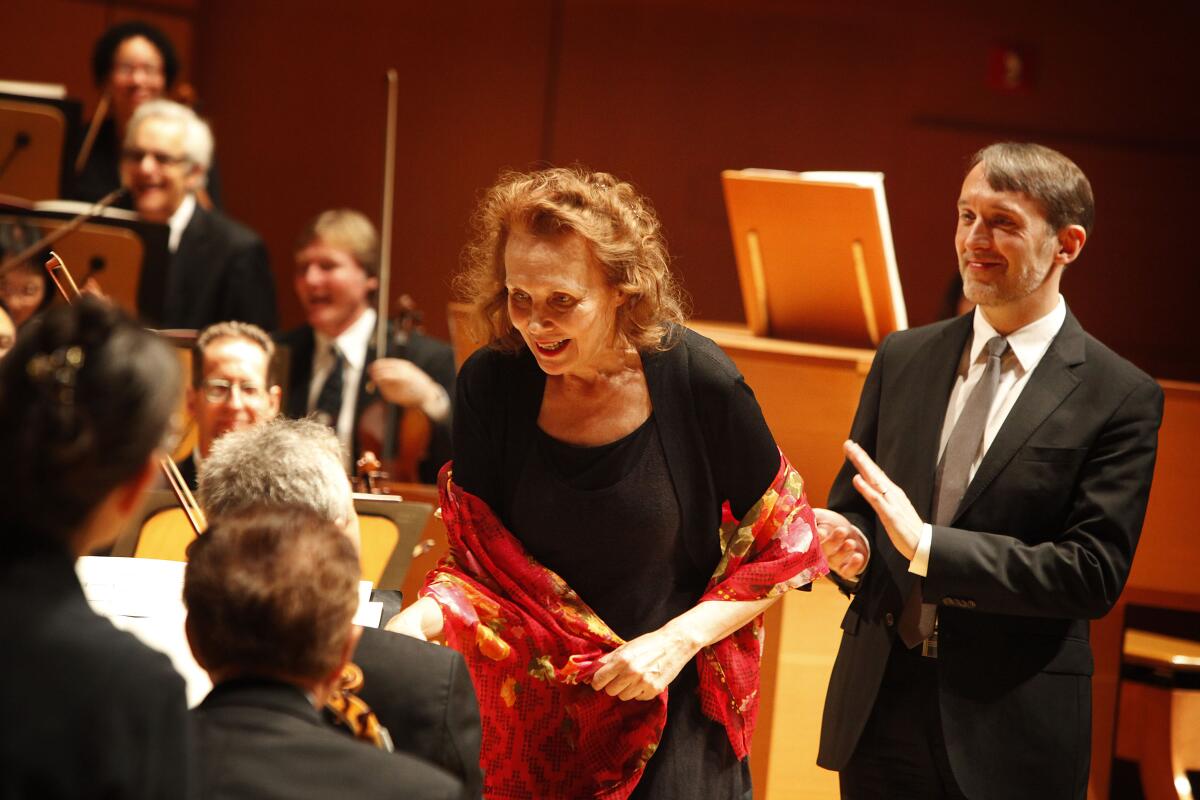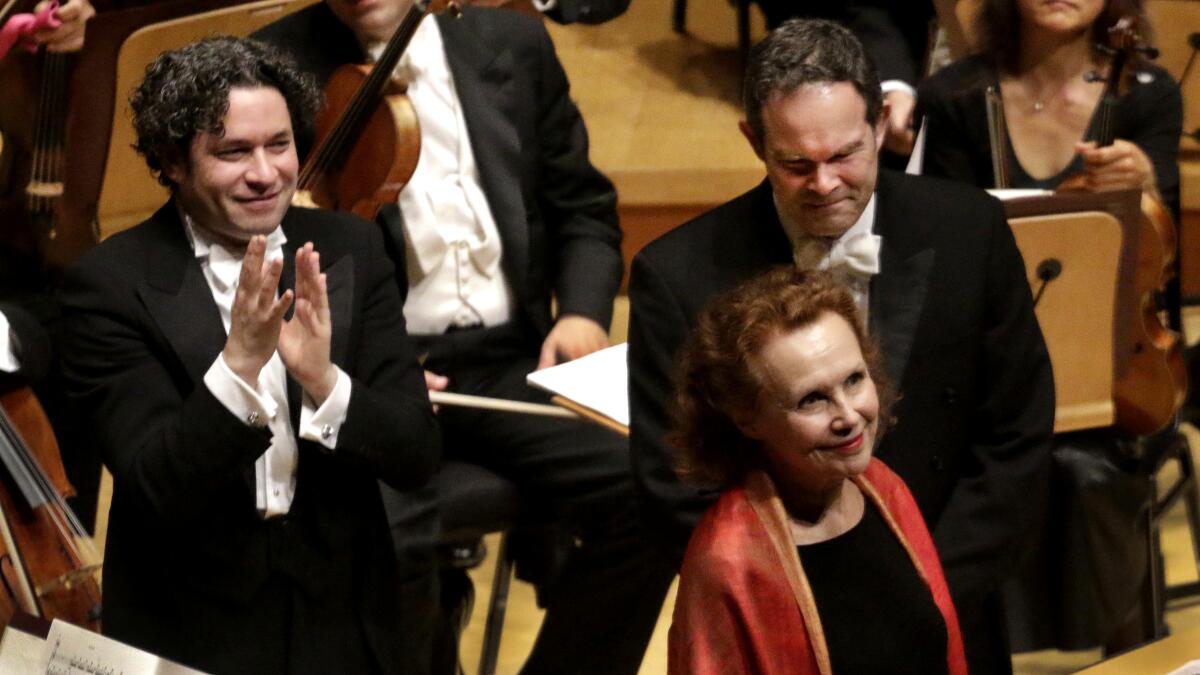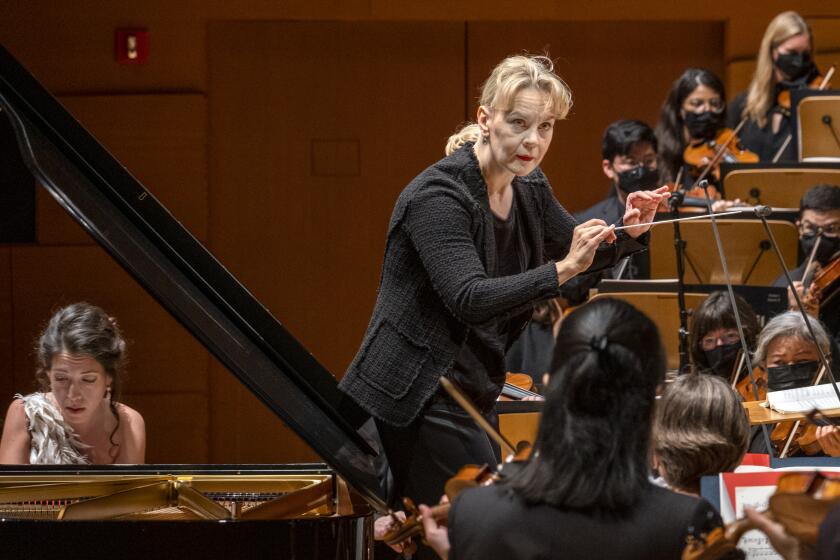Appreciation: Composers are often revered but rarely beloved. Kaija Saariaho was both

This year’s Ojai Festival began Thursday night with a tribute to Kaija Saariaho, the Finnish composer who died earlier this month. For Ojai, Steven Schick performed an ethereal percussion piece inspired by the moss garden at the Kyoto temple Saiho-ji, which is the greenest place I have ever visited. Saiho’s overpowering mossy scent engenders a marvelous sense of peace, and Saariaho’s miniature, the fifth movement of her “Six Japanese Gardens,” magically captures it, even when experienced, as I did, via the festival’s livestream.
At precisely the same moment, Saariaho’s life-long friend, Esa-Pekka Salonen, happened to be leading the San Francisco Symphony in a performance of her war-themed second opera, “Adriana Mater.” The premiere in Paris 17 years ago had been a shocker. “Adriana” examines the way war ravishes love and the sacrifices required to maintain equanimity. Saariaho tells us not what war is but what it means.
There has been an enormous outpouring of love for Saariaho on hearing of her death at 70 from glioblastoma. Composers are admired; they are revered; they get under our skin, leaving us with sounds that remain in our consciousness; the best can seem essential to our very being. But beloved? That’s rare.
Saariaho was all of the above. Her music has informed aspects of European, American and Asian music, and she is being well and properly eulogized. Along with her key contributions to 21st century opera, she leaves us with an expansive set of solo pieces (she had a particular flair for flute, violin, cello and the voice), chamber works and orchestral scores. She frequently employed electronics to enhance the sonic aura. The adjective most commonly used to describe her music (and her) is luminous — no other will do.
The abstract musical study, which saw its U.S. premiere at the LA Phil, was inspired by the California coast and taps into an inevitable sense of foreboding.
As a member of the generation of Finnish composers and performers who burst upon the world musical stage in the 1980s, Saariaho, along with Salonen and Magnus Lindberg, formed an inseparable trio of firebrand composers when students at the Sibelius Academy in Helsinki. They and their friends created the rebellious Korvat Auki (Ears Open!) collective to promote — and sometimes force upon an unsuspecting public — the most advanced forms of rigorously devised music. If music wasn’t difficult, it wasn’t worth it for them.
There were particular obstacles for Saariaho. She never liked being called a pioneering woman composer, because she felt making the distinction was, in itself, demeaning. But Finland had had no women composers of note who could serve as a role model, and electronic music was seen as a man’s realm. “Who would listen to Saariaho’s music,” Finland’s leading music critic, Seppo Heikinheimo, wrote in 1990, “if she were an ugly woman?” This was what she was up against.
Attracted to IRCAM, the computer music studio Pierre Boulez created for Centre Pompidou, Saariaho wound up settling in Paris. A new generation of composers at IRCAM had begun employing computers to create a harmonic language made from the overtones of pitches they dubbed spectral music. It was the logical next step for French music after the Impressionism of Debussy and Ravel, followed by the post-serialism of Boulez.
But while Saariaho often set her vocal music to French texts, she liked to describe herself as a Finn in France. An outsider. She put herself in her music but as an observer. The result was work that felt objective yet remained intimate. Or is it the other way around? In either case, we see ourselves though her ears.
What has gotten less attention is the role our West Coast played in all this. In the late 1980s, Saariaho spent a year teaching at the University of California San Diego. She was, in a sense, returning to the source. The university’s computer music program, along with the groundbreaking one at Stanford University, was Boulez’s model for IRCAM.

Once Salonen became music director of the Los Angeles Philharmonic in 1992, he regularly programmed Saariaho, playing and premiering works in both the regular orchestra concert series and the new-music Green Umbrella. This quickly let to her introduction to Peter Sellars, who guided her into opera, beginning with “L’Amour de Loin” (“Love From Afar”), which Sellars directed and which became Saariaho’s best-known work. Its premiere at the 2000 Salzburg Festival felt almost L.A. from afar. The conductor was Kent Nagano, another Californian who had just been named the first music director of Los Angeles Opera. Funding came from Beverly Hills philanthropist Betty Freeman.
In “L’Amour,” like so much of Saariaho’s work, music resonates in every meaningful sense of the word. It resonates as the vibrations of pure physical sound, be it that of the human voice, of instruments or sounds produced by electronics. It resonates as the inner essence of soul. It resonates as the light waves of the mysterious universe, their spectra of color visible and invisible.

That was Saariaho. In her visits here over the past 35 years, she invariably left behind dollops of her luminescence. Still, we helped embolden that glow. She took considerable inspiration from working with our soloists and ensembles, as she did from the physical environment, SoCal spirituality and our technology. The L.A. Phil and Walt Disney Concert Hall were another home.
The Sellars/Saariaho collaboration continued with one extraordinary work after another, no two alike. In 2016, the year Sellars served as music director of the Ojai Festival, he made Saariaho the featured composer. Her relationships with such L.A. performers as pianist Gloria Cheng, violinist Movses Pogossian and the Calder Quartet led to transcendent recordings of her works, placing them in wider contexts of composers ranging from Bach to Messiaen.
Saariaho’s last public appearance was shortly before her death for the U.K. premiere of her triumphant final opera, “Innocence,” which will reach San Francisco Opera next year. Right after she had finished it, in 2019, she came to Disney for the L.A. Phil’s performance of her new harp concerto, “Trans.” On that trip, she visited UCSD, and the drive on the 5 freeway between La Jolla and L.A. inspired one of her last major orchestral works, “Vista,” just as a trip to Kyoto 30 years ago had led to “Six Japanese Gardens.”
Japan and L.A. remained very much allied in Saariaho. In 2015, Saariaho and Sellars collaborated on “Only the Sound Remains,” a starkly brilliant opera based on Nôh plays. The U.S. premiere had been scheduled for Ojai, but because of the complexity of the electronics, there was no site where it would work.
Still, for us, the Saariaho sound very much remains. She tamed the computer, and at what seems a cosmic moment in the interaction between humanity and technology, she matters more than ever. With her music and her machines and her luminosity, Saariaho reminds us of what is at stake.
More to Read
The biggest entertainment stories
Get our big stories about Hollywood, film, television, music, arts, culture and more right in your inbox as soon as they publish.
You may occasionally receive promotional content from the Los Angeles Times.












